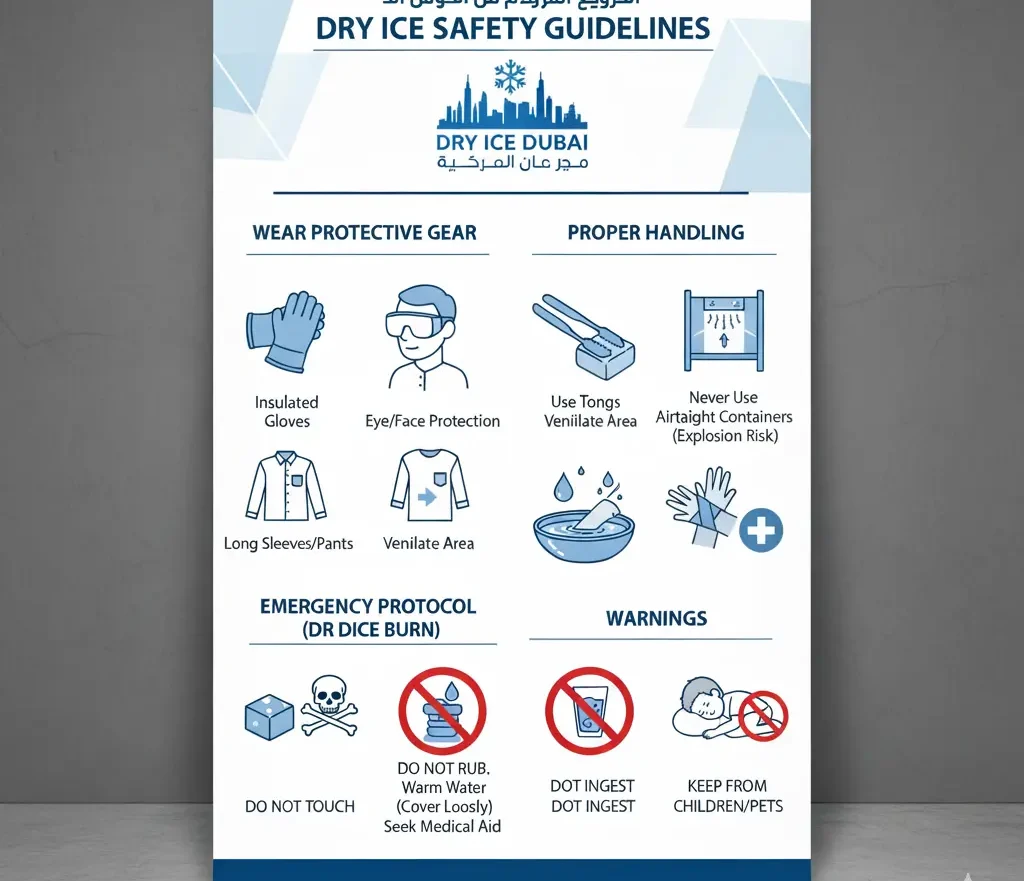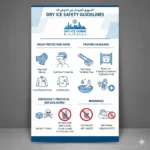Dry ice is a fascinating substance, capable of creating dramatic fog effects and maintaining ultra-cold temperatures for a variety of applications. However, its extreme cold also presents a significant safety risk: dry ice burns. If you’ve ever wondered, “Are dry ice burns permanent?” or how to treat them, you’re seeking crucial information. At Dry Ice Dubai, your trusted dry ice supplier across the UAE, we prioritize safety and want to equip you with the knowledge to handle this powerful substance responsibly.
What is a Dry Ice Burn?
A dry ice burn isn’t a traditional heat burn; it’s a form of frostbite caused by prolonged exposure to extremely cold temperatures. Dry ice, which is solid carbon dioxide (CO₂), maintains a temperature of -78.5°C (-109.3°F). When it comes into direct contact with skin, it rapidly freezes the water in skin cells, damaging tissues and nerves. This damage can range from superficial to severe, much like heat burns.
Symptoms and Stages of Dry Ice Burns
Recognizing the symptoms of a dry ice burn (frostbite) early is key to minimizing damage. The severity can be classified into stages:
First-Degree Burn (Superficial Frostnip):
- Symptoms: Skin appears pale, red, or yellowish/gray. It might feel cold, numb, tingly, or itchy. There’s usually no permanent tissue damage, though the area might be sensitive for a while.
Second-Degree Burn (Superficial Frostbite):
- Symptoms: The skin may appear hard, waxy, and frozen. Blisters, often filled with clear or milky fluid, typically develop within 24-48 hours after rewarming. The skin underneath the blisters can be swollen and red. This stage indicates some tissue damage, but it’s usually not permanent.
Third-Degree Burn (Deep Frostbite):
- Symptoms: The skin feels hard, cold, and numb, and may look blue, purple, or black. Blisters will be blood-filled. Tissue damage extends to deeper layers, including muscles, tendons, and bones.
Fourth-Degree Burn (Deep Frostbite with Tissue Loss):
- Symptoms: The affected area is completely numb and frozen solid. Skin turns dark (black/gangrene) and tissue death occurs.
Are Dry Ice Burns Permanent?
The direct answer is: Dry ice burns can be permanent, depending on their severity and how quickly and effectively they are treated.
First and Second-Degree Burns: These are generally not permanent if treated promptly and correctly. The skin will typically heal completely, although the affected area might remain more sensitive to cold, prone to blistering, or experience temporary discoloration.
Third and Fourth-Degree Burns: These burns are much more serious and often result in permanent damage. This can include:
- Tissue Loss: The affected skin and underlying tissues may die, requiring surgical removal (debridement) or even amputation.
- Chronic Pain: Persistent nerve damage can lead to long-term pain, numbness, or tingling.
- Increased Cold Sensitivity: The area may always be more susceptible to cold.
- Changes in Sensation: Permanent altered sensation, such as persistent numbness.
- Scarring: Significant scarring is common.
- Infection: Dead tissue is highly susceptible to infection, which can lead to further complications.
The key determinant for whether a dry ice burn causes permanent damage is the depth and duration of exposure and the immediacy of appropriate first aid.
First Aid for Dry Ice Burns
If you or someone else experiences a dry ice burn, immediate action is crucial:
- Remove Clothing/Jewelry: Carefully remove any clothing or jewelry around the affected area, as these can restrict blood flow as swelling occurs.
- Gently Rewarm: Immerse the affected area in warm (not hot) water, approximately 37-40°C (98-104°F). This is slightly warmer than body temperature. Do NOT use hot water, as this can cause further damage.
- Maintain Warmth: Keep the area immersed until the skin becomes soft and sensation returns. This may take 20-30 minutes.
- Cover Loosely: After rewarming, dry the area gently and cover it with sterile, non-stick bandages. Separate frostbitten fingers or toes with sterile gauze.
- Elevate: Elevate the injured area to reduce swelling.
- Pain Relief: Over-the-counter pain relievers like ibuprofen can help manage pain and inflammation.
IMPORTANT: Do NOT rub or massage the affected area, as this can cause further tissue damage. Do NOT use direct heat (e.g., heating pads, fireplace) or refreeze the area.
When to Seek Medical Attention
Always seek professional medical attention for any dry ice burn beyond a very mild, first-degree burn. It’s particularly important to see a doctor if:
- The skin shows signs of blistering, hardness, discoloration (blue, purple, black), or complete numbness.
- The affected area is large or involves critical parts like the face, hands, or feet.
- Signs of infection develop (increased pain, swelling, redness, pus).
- You are unsure about the severity of the burn.
Preventing Dry Ice Burns: Dry Ice Safety Best Practices
Prevention is always the best approach when handling dry ice. Dry Ice Dubai emphasizes these critical safety practices:
Always Wear Protective Gear:
- Insulated Gloves: Heavy-duty, insulated gloves (e.g., cryo-gloves or thick leather gloves) are essential. Standard fabric gloves are insufficient.
- Eye Protection: Safety goggles or a face shield prevent eye contact with dry ice particles or CO₂ vapor.
- Long Sleeves and Pants: Cover exposed skin to prevent accidental contact.
Ensure Proper Ventilation: Dry ice sublimates (turns directly from solid to gas) into carbon dioxide, which is heavier than air. In enclosed spaces, CO₂ can displace oxygen, leading to asphyxiation. Always use dry ice in well-ventilated areas.
Never Store in Airtight Containers: As dry ice sublimates, it releases CO₂ gas. If stored in an airtight container, the pressure can build up and cause the container to explode. Use specially designed dry ice storage containers or coolers with loose-fitting lids.
Handle with Care: Use tongs or heavy-duty scoops to move dry ice. Avoid direct skin contact at all costs.
Educate Others: Inform anyone who will be around dry ice about the potential hazards and proper handling procedures.
Keep Out of Reach of Children and Pets: Dry ice should only be handled by trained adults.
Do Not Ingest: Never put dry ice in your mouth or swallow it. It can cause severe internal frostbite.
Proper Disposal: Allow dry ice to sublimate completely in a well-ventilated area outdoors. Do not dispose of it in drains, toilets, or trash cans, as it can damage plumbing or cause pressure build-up.
By following these safety guidelines, you can harness the incredible power of dry ice without risking painful or permanent injury. Dry Ice Dubai is committed to providing not only the highest quality dry ice products but also comprehensive safety information for all our customers in Dubai and across the UAE.
Conclusion
While dry ice burns can be severe and potentially permanent, especially in higher degrees, prompt and correct first aid, coupled with immediate medical attention when necessary, can significantly mitigate long-term damage. The best defense, however, remains prevention. By understanding the risks and adhering to strict safety protocols, you can ensure a safe experience with dry ice for all your cooling, cleaning, or special effects needs.
For certified, high-quality dry ice and expert advice on safe handling, trust Dry Ice Dubai – your premier supplier in the UAE.
Frequently Asked Questions (FAQs) About Dry Ice Burns
How quickly can dry ice cause a burn?
Dry ice can cause a burn very quickly, often within a few seconds of direct or prolonged skin contact, due to its extremely low temperature. The severity depends on the duration of contact and the pressure applied.
Can I get frostbite from dry ice vapor?
While direct skin contact with solid dry ice is the primary cause of burns, prolonged exposure to concentrated dry ice vapor (CO₂ gas) in an unventilated area could potentially contribute to frostnip or respiratory issues due to oxygen displacement. However, it’s highly unlikely to cause a direct burn like solid dry ice does.
What's the difference between a dry ice burn and a regular burn?
A regular burn is caused by heat, leading to cell damage through coagulation of proteins. A dry ice burn (frostbite) is caused by extreme cold, which freezes the water in cells, causing ice crystal formation and cell disruption. Both result in tissue damage but through different mechanisms.
Should I use a heating pad for a dry ice burn?
No, never use direct heat sources like heating pads, hot water bottles, or fires to rewarm a dry ice burn. Rapid or excessive heating can cause further tissue damage. Always use warm (not hot) water for rewarming.
Can I put dry ice in drinks for smoky effects?
While popular for special effects, dry ice should never be ingested or placed directly into drinks where it could be accidentally consumed. If using it for smoky drink effects, ensure it’s in a separate compartment or a container that prevents direct contact with the liquid and can be easily removed before consumption. Always supervise its use closely.
Where can I find reliable dry ice safety guidelines in Dubai?
As a certified supplier, Dry Ice Dubai provides comprehensive safety information and proper handling instructions with all our dry ice products. We are dedicated to ensuring our customers use dry ice safely and effectively across the UAE. Contact our team for specific safety advice or refer to our website’s safety resources.






